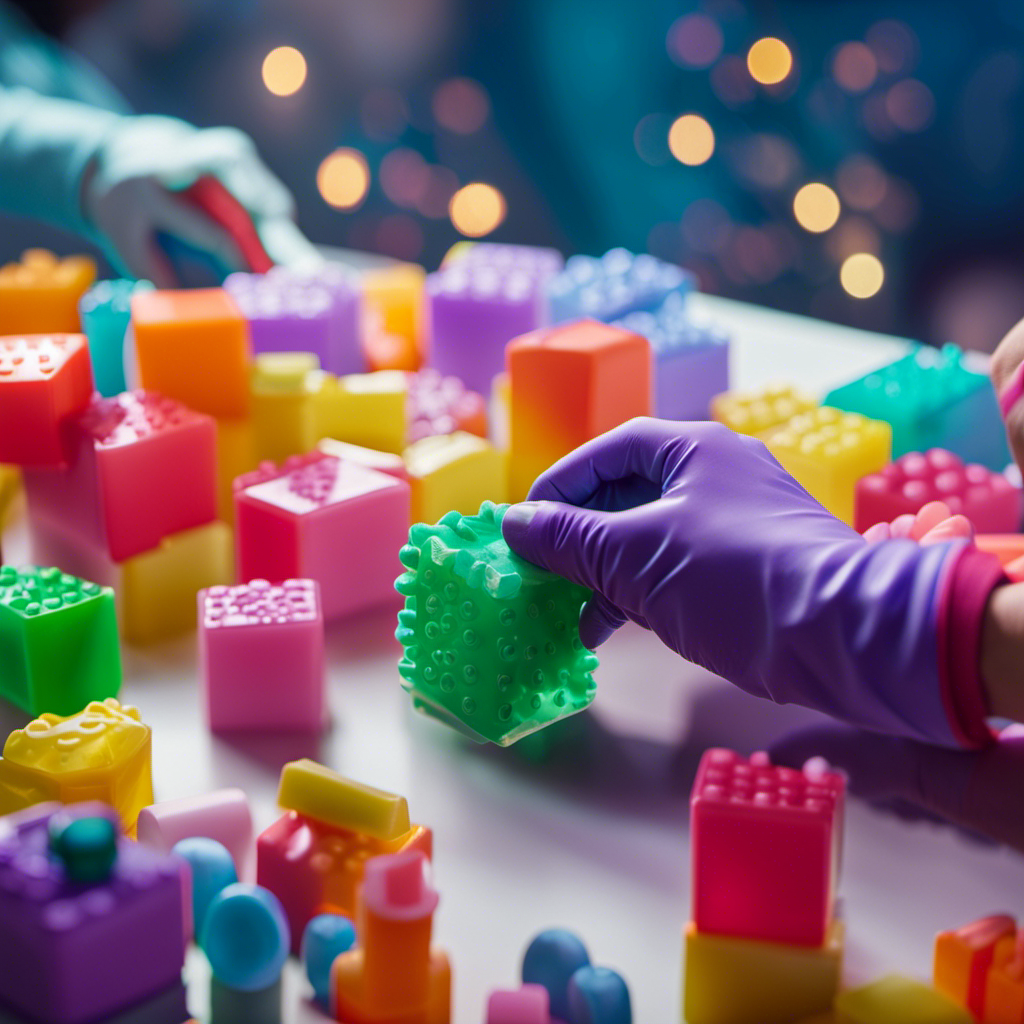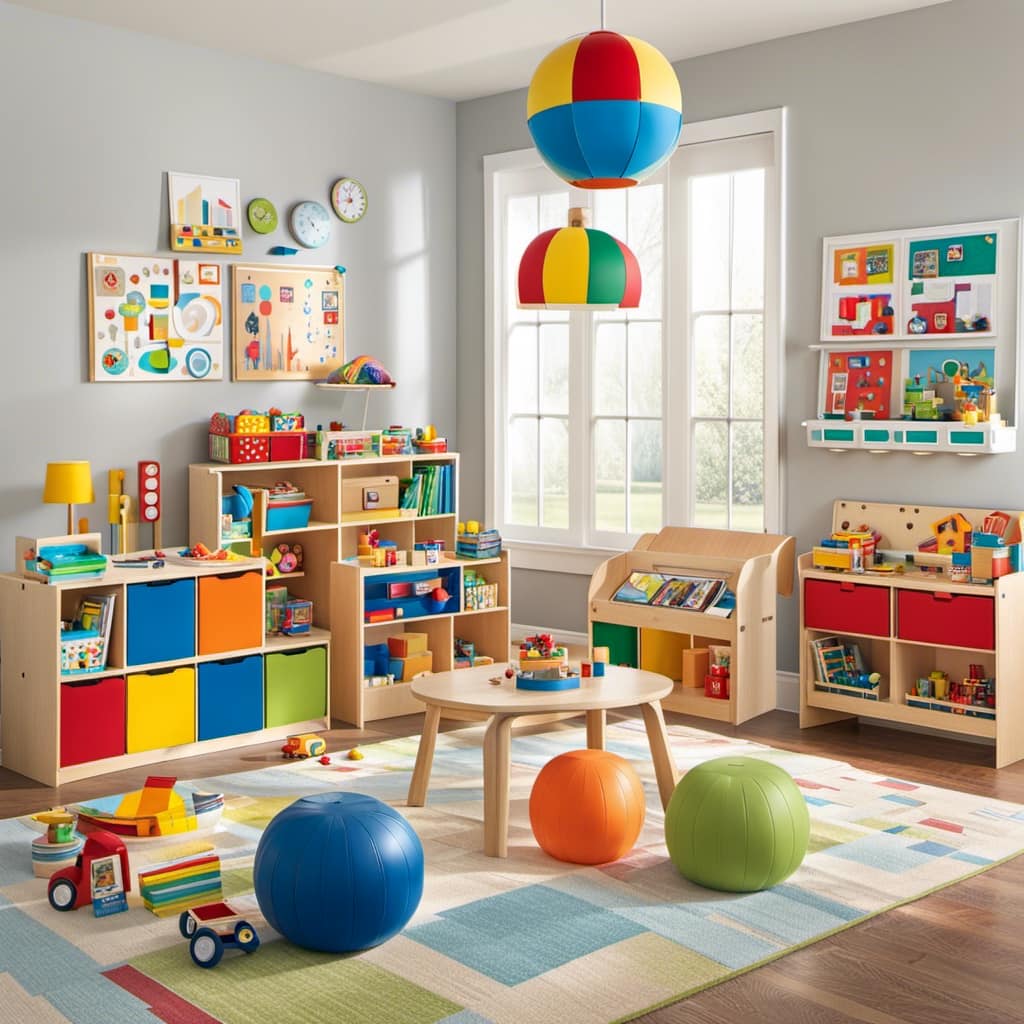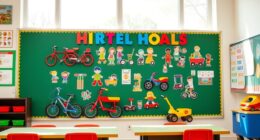As a parent or caregiver of a child, I recognize the importance of keeping preschool toys clean and free of germs. Since young children often put toys in their mouths, it is essential to ensure a safe and hygienic environment for their playtime activities.
That’s why I’m here to guide you through the process of sanitizing preschool toys. From choosing the right cleaning products to establishing a routine, this article will provide you with practical tips and step-by-step instructions to keep those toys squeaky clean and your little ones happy and healthy.
Key Takeaways
- Regularly sanitize preschool toys to minimize the risk of illness.
- Use child-friendly cleaning products specifically designed for toys.
- Choose the appropriate cleaning method based on the toy’s material.
- Store toys in clean and dry containers or bins, and regularly inspect and discard broken or damaged toys.
Understanding the Importance of Toy Sanitization
You should understand the importance of toy sanitization to keep your preschoolers healthy and safe. As a parent or caregiver, it is crucial to be aware of the potential for germ transmission through toys. Young children often put toys in their mouths, making them more susceptible to bacteria and viruses. By regularly sanitizing their toys, you can minimize the risk of illness and create a cleaner environment for your little ones.
Toy storage plays a significant role in preventing the spread of germs. It’s essential to have a designated area for toys and avoid mixing them with other household items. This helps to reduce the chances of cross-contamination. Consider using storage bins or shelves to keep toys organized and easily accessible. Additionally, make sure to clean and disinfect the storage containers regularly to maintain a hygienic environment for the toys.
Understanding the importance of toy sanitization is just the first step in keeping your preschoolers safe. The next section will delve into the types of germs and bacteria that can be found on preschool toys and provide strategies for effective sanitization.
Types of Germs and Bacteria on Preschool Toys
When handling preschool toys, be aware of the various types of germs and bacteria that could be present. It is important to understand the potential risks associated with these microorganisms in order to effectively disinfect and sanitize the toys. Here are some common types of harmful bacteria that can be found on preschool toys:
| Bacteria | Symptoms | Transmission |
|---|---|---|
| Staphylococcus | Skin infections, food poisoning | Direct contact, airborne |
| E. coli | Diarrhea, abdominal pain | Contaminated food, water |
| Salmonella | Diarrhea, fever | Contaminated food, water |
| Streptococcus | Sore throat, skin infections | Direct contact, airborne |
To ensure the safety of children, it is crucial to employ effective disinfection techniques. Regular cleaning with soap and water is a good start, but it may not eliminate all harmful bacteria. Disinfecting wipes or sprays containing alcohol or bleach are highly effective in killing germs on toys. It is important to follow the manufacturer’s instructions and allow the disinfectant to sit on the toy for the recommended contact time. Additionally, consider using a dishwasher for plastic toys that are dishwasher-safe, as the high heat can help kill bacteria. By understanding the types of harmful bacteria and implementing proper disinfection techniques, we can create a clean and germ-free environment for our little ones.
When it comes to toy sanitization, choosing the right cleaning products is essential.
Choosing the Right Cleaning Products for Toy Sanitization
Choosing the right cleaning products is crucial for effectively disinfecting and eliminating harmful bacteria on toys. When it comes to cleaning preschool toys, it is important to prioritize the safety of children by using child-friendly cleaning products. Look for products that are labeled as non-toxic and specifically designed for cleaning toys. These products are formulated to be gentle on delicate surfaces and safe for children to come into contact with.
In addition to being child-friendly, it is also important to consider eco-friendly sanitizing options. Many cleaning products contain harsh chemicals that can be harmful to the environment. Instead, opt for environmentally friendly alternatives that are made from natural ingredients and are biodegradable. These products not only protect the planet, but they also ensure that your child is not exposed to unnecessary chemicals during playtime.
Transitioning into the subsequent section about the step-by-step guide to cleaning soft toys, it is important to note that different types of toys require different cleaning methods. Soft toys, in particular, require special attention due to their delicate nature. So, let’s now explore a practical guide on how to effectively clean and sanitize soft toys without compromising their quality and safety.
Step-by-Step Guide to Cleaning Soft Toys
To effectively clean and maintain the quality of soft toys, start by checking the label for any specific washing instructions. Understanding the importance of regular toy cleaning is crucial for ensuring the health and safety of children. Soft toys can harbor dirt, dust, and allergens, so it is essential to clean them regularly. When it comes to choosing the right cleaning products for soft toys, it is important to consider the material of the toy and any specific instructions provided by the manufacturer.
Here is a table that provides a guide on the appropriate cleaning methods for different types of soft toys:
| Material | Cleaning Method |
|---|---|
| Plush | Machine wash |
| Stuffed | Surface clean |
| Furry | Spot clean |
| Chenille | Hand wash |
How to Disinfect Plastic Toys Safely
When it comes to keeping our children safe and healthy, effective disinfecting methods and child-friendly sanitizing solutions are vital.
As a parent, I understand the importance of finding ways to effectively disinfect our children’s toys and play areas without compromising their safety.
In this discussion, I will explore various methods and solutions that are both effective in killing germs and safe for our little ones.
Effective Disinfecting Methods?
If you want to effectively disinfect preschool toys, you should consider using a bleach solution. Bleach is a powerful disinfectant that kills a wide range of germs and bacteria. However, it is important to use it carefully and follow the instructions on the label.
If you prefer to use child-friendly disinfectants or natural toy cleaning methods, there are alternatives available. Some child-friendly disinfectants are specially formulated to be safe for children and effective in killing germs on toys. Natural methods, such as using vinegar or tea tree oil, can also be effective in disinfecting toys. These methods are great options for parents who prefer to avoid harsh chemicals.
Child-Friendly Sanitizing Solutions?
Consider using child-friendly disinfectants or natural cleaning methods for effective and safe sanitizing. When it comes to cleaning preschool toys, it’s important to prioritize the health and safety of children.
Here are some options to consider:
-
Vinegar and water solution: Mix equal parts of white vinegar and water in a spray bottle. This natural solution is effective in killing germs and is safe for children.
-
Hydrogen peroxide: Dilute hydrogen peroxide with water and use it as a cleaning solution. It is an excellent disinfectant and can be used on a variety of surfaces.
-
Steam cleaning: Steam cleaners are a great way to sanitize toys without using chemicals. The high temperature kills germs and bacteria effectively.
-
Baking soda paste: Make a paste using baking soda and water. Scrub the toys gently with this paste to remove dirt and sanitize them naturally.
-
Essential oils: Certain essential oils like tea tree oil and lavender oil have antimicrobial properties. Mix a few drops with water and use it to wipe down toys.
By using child-friendly disinfectants and natural cleaning methods, you can ensure that preschool toys are sanitized without any harmful chemicals.
Now, let’s move on to the next section about sanitizing wooden toys: tips and tricks.
Sanitizing Wooden Toys: Tips and Tricks
To sanitize wooden toys, it’s important to follow proper cleaning techniques. Wooden toys require special care to maintain their quality and longevity. Using natural cleaning solutions for wooden toys not only helps to sanitize them but also keeps them free from harmful chemicals. Here are some tips and tricks for cleaning and sanitizing wooden toys:
| Cleaning Solution | Instructions | Benefits |
|---|---|---|
| Vinegar Solution | Mix equal parts of white vinegar and water. Use a clean cloth or sponge to wipe down the toys. | Vinegar is a natural disinfectant that kills germs and bacteria. It is also safe for children and does not leave any residue. |
| Lemon Juice Solution | Mix lemon juice with water in a 1:1 ratio. Apply the solution to the toys using a soft cloth. | Lemon juice has antibacterial properties and leaves a fresh scent on the toys. |
| Tea Tree Oil Solution | Mix a few drops of tea tree oil with water. Use a cloth or spray bottle to apply the solution to the toys. | Tea tree oil is a natural antiseptic that effectively kills germs and bacteria. |
Cleaning and disinfecting wooden toys regularly is essential for maintaining a hygienic play environment. Once you have completed sanitizing your wooden toys, it’s time to move on to cleaning and disinfecting electronic toys without compromising their functionality or safety.
Cleaning and Disinfecting Electronic Toys
Once you’ve finished cleaning and disinfecting your wooden toys, it’s time to move on to the next step: cleaning and disinfecting your electronic toys. Electronic toys can be a breeding ground for germs, especially battery operated toys and touch screen toys that are frequently handled by children.
Here are three important steps to effectively disinfect your electronic toys:
-
Remove batteries: Before starting the cleaning process, always remove the batteries from battery operated toys. This not only prevents any potential damage to the toy but also ensures safety during the cleaning process.
-
Wipe with a disinfectant: Use a gentle disinfectant wipe or a soft cloth dampened with a mixture of water and mild soap to clean the surface of the electronic toy. Pay special attention to areas that are frequently touched, such as buttons and switches. Make sure to avoid getting any liquid into the electronic components.
-
Dry thoroughly: After cleaning, allow the toy to air dry completely before inserting new batteries or turning it on. This will help prevent any damage to the electronic components and ensure the toy is ready for play.
Ensuring hygiene while sanitizing water toys involves a different set of steps to follow, which will be discussed in the next section.
Ensuring Hygiene While Sanitizing Water Toys
To ensure proper hygiene when cleaning your water toys, it’s important to follow a specific set of steps. Water toys can easily become dirty and harbor bacteria if not cleaned regularly. Here are some tips on how to sanitize your water toys effectively:
| Step | Method |
|---|---|
| 1 | Rinse the toys thoroughly with clean water to remove any dirt or debris. |
| 2 | Prepare a solution of child-friendly disinfectant following the manufacturer’s instructions. |
| 3 | Submerge the toys in the disinfectant solution for the recommended amount of time. |
| 4 | Scrub the toys gently with a soft brush to remove any stubborn dirt or grime. |
| 5 | Rinse the toys again with clean water to remove any residue from the disinfectant. |
| 6 | Allow the toys to air dry completely before storing them. |
When it comes to choosing child-friendly disinfectants, it’s important to opt for products that are specifically designed for toys and are safe for children. Look for disinfectants that are non-toxic, free from harsh chemicals, and approved for use around children. Alternatively, you can also consider using natural toy cleaning alternatives such as vinegar and water solution or a mixture of baking soda and water. These natural options can be just as effective in killing bacteria and keeping your water toys clean and safe for your little ones to play with.
Now, let’s move on to dealing with stuffed animals and fabric toys.
Dealing With Stuffed Animals and Fabric Toys
When cleaning stuffed animals and fabric toys, it is important to check the care label for specific instructions. Properly cleaning plush toys and fabric toys requires a gentle touch and the right cleaning methods to ensure their longevity and cleanliness.
Firstly, remove any loose dirt or debris from the toys by gently brushing or shaking them outdoors. For small fabric toys, a lint roller can also be used to remove dust or hair.
Next, check the care label for any specific cleaning instructions. Some toys may be machine washable, while others may require hand washing. If machine washing is an option, place the toys in a laundry bag or pillowcase to protect them during the wash cycle. Use a gentle detergent and choose a delicate or gentle cycle to avoid damaging the toys.
If hand washing is necessary, fill a basin with warm water and a mild detergent. Gently agitate the toys in the water, paying extra attention to any stained areas. Rinse them thoroughly and squeeze out any excess water. Allow the toys to air dry completely before giving them back to your child.
Now, let’s move on to the next section about sanitizing art and craft supplies for preschoolers.
Sanitizing Art and Craft Supplies for Preschoolers
Now, it’s important to remember the cleanliness of art and craft supplies for preschoolers. Understanding the importance of toy hygiene is crucial to ensure the health and safety of young children. Here are some safe and effective cleaning methods for art supplies:
-
Washable paints: Use warm soapy water to clean paintbrushes and palettes. Rinse them thoroughly and allow them to air dry before storing.
-
Glue and adhesive materials: Wipe off excess glue from brushes and containers with a damp cloth. For stubborn residue, soak in warm water and gently scrub with a toothbrush.
-
Playdough and modeling clay: If the dough becomes dirty or mixed with other colors, it’s best to replace it. However, if it’s still in good condition, you can wipe it with a damp cloth to remove any surface dirt.
Keeping art and craft supplies clean not only prevents the spread of germs but also maintains their quality and longevity. By following these cleaning methods, you can ensure that preschoolers have a safe and enjoyable experience while creating their masterpieces.
As we move on to the next section about tips for cleaning outdoor toys, it’s important to continue prioritizing the cleanliness and hygiene of the toys children play with.
Tips for Cleaning Outdoor Toys
After discussing the importance of sanitizing art and craft supplies for preschoolers, let’s move on to another essential aspect of maintaining a clean and safe environment for children: cleaning outdoor toys.
Outdoor play is not only fun but also offers numerous developmental benefits for preschoolers. However, it also means that toys can get dirty and covered in dirt and grime. Cleaning sand toys and removing dirt and grime from outdoor toys is crucial to ensure the health and well-being of children.
To clean sand toys, start by shaking off any excess sand. Then, rinse the toys thoroughly with water to remove any remaining sand particles. Use a mild detergent and warm water to scrub the toys gently, paying particular attention to any crevices or hard-to-reach areas. Rinse the toys again to remove any soap residue, and let them air dry in the sun.
For other outdoor toys, such as plastic slides or playhouses, start by removing any loose dirt or debris. Then, use a mixture of warm water and mild detergent to scrub the surfaces. Rinse well to remove any soap residue, and allow the toys to dry completely before allowing children to play with them again.
Sanitizing Toys in a Preschool Setting
In a preschool setting, ensuring the cleanliness of toys is crucial for the health and well-being of children.
When it comes to sanitizing toys, it is important to use the best methods that effectively kill germs and bacteria.
Additionally, establishing a regular schedule for sanitization is essential to maintain a clean and safe environment for the little ones.
Best Sanitizing Methods
To effectively sanitize preschool toys, you’ll want to consider the best methods available. Ensuring that the toys are clean and free from germs is essential for the health and safety of the children. Here are three child-friendly disinfectants and natural sanitizing methods that you can use:
-
Child-friendly disinfectants: Look for disinfectants specifically formulated for use around children. These products are designed to be safe and effective, killing germs without harmful chemicals.
-
Natural sanitizing methods: You can also opt for natural alternatives such as vinegar and water solution or hydrogen peroxide. These natural agents have antimicrobial properties and can effectively sanitize toys without any harsh chemicals.
-
Regular washing: Regularly washing the toys with soap and water is a simple yet effective way to keep them clean. This method removes dirt, grime, and some germs, reducing the risk of infection.
By using child-friendly disinfectants and natural sanitizing methods, you can ensure the toys in your preschool are clean and safe for the children to play with.
Now, let’s move on to discussing the importance of frequency of sanitization in maintaining a hygienic environment.
Frequency of Sanitization
Now that we have discussed the best sanitizing methods for preschool toys, let’s talk about the frequency of sanitization. Regular cleaning and sanitizing of toys is essential to maintain a healthy and safe environment for children. Not only does it help prevent the spread of germs and illnesses, but it also prolongs the lifespan of the toys.
To give you a better idea, here is a table outlining the recommended frequency of sanitization for different types of toys:
| Type of Toy | Frequency of Sanitization |
|---|---|
| Stuffed Animals | Once a week |
| Plastic Toys | Daily |
| Board Games | After each use |
By adhering to these guidelines, you can ensure that the toys in your preschool remain clean and safe for the children to play with.
Transitioning into the next section, let’s now discuss how to establish a toy cleaning routine for maximum safety.
Establishing a Toy Cleaning Routine for Maximum Safety
Remember, it’s important to establish a toy cleaning routine for maximum safety when sanitizing preschool toys. By following a regular cleaning schedule, you can ensure that the toys remain hygienic and safe for children to play with.
Here are some practical steps to help you maintain toy hygiene:
-
Use child-friendly cleaning products: When cleaning preschool toys, it’s crucial to choose cleaning products that are safe for children. Look for non-toxic and eco-friendly options that are specifically designed for toy cleaning. Avoid harsh chemicals that may be harmful if ingested or touched by young children.
-
Separate toys by category: Divide the toys into different categories such as soft toys, plastic toys, and wooden toys. This will make it easier to clean and sanitize them effectively. Soft toys can often be machine washed, while plastic and wooden toys can be wiped down with a cloth soaked in a mild cleaning solution.
-
Clean high-touch areas: Pay extra attention to high-touch areas such as buttons, handles, and wheels. These areas are more likely to harbor germs and bacteria. Use a toothbrush or a small brush to clean these hard-to-reach spots thoroughly.
-
Allow toys to dry completely: After cleaning, make sure to allow the toys to air dry completely before allowing children to play with them again. This will help prevent the growth of mold and mildew.
Frequently Asked Questions
How Can I Clean and Sanitize Electronic Toys?
When it comes to cleaning electronic toys, there are a few best practices for sanitizing them.
First, make sure to unplug the toy and remove any batteries.
Then, use a damp cloth with a mild soap to wipe down the surfaces. Be careful not to get any water inside the toy.
For hard-to-reach areas, use a cotton swab dipped in rubbing alcohol.
Are There Any Specific Cleaning Products I Should Use for Wooden Toys?
When it comes to cleaning wooden toys, it’s important to choose the right cleaning products. Natural cleaning solutions can be a great option for preschool toys. They are gentle yet effective in removing dirt and germs without causing any harm to the wood.
Look for cleaning products specifically designed for wooden surfaces, and always read the instructions carefully before using them. Remember, keeping preschool toys clean and sanitized is essential for the health and safety of the children.
What Are the Different Types of Germs and Bacteria That Can Be Found on Preschool Toys?
There are various types of pathogens that can be found on preschool toys, including bacteria, viruses, and fungi. It is important to regularly clean and sanitize these toys to prevent the spread of germs and keep the children healthy.
Regular toy cleaning is essential in maintaining a safe and hygienic environment in preschools. By using appropriate cleaning products and techniques, we can effectively eliminate these harmful pathogens and ensure the well-being of the children.
How Often Should I Clean Outdoor Toys to Ensure Maximum Safety?
Cleaning outdoor toys regularly is crucial for ensuring maximum safety. Proper maintenance of these toys is essential to prevent the buildup of dirt, bacteria, and other harmful substances.
To keep them clean, I recommend using recommended cleaning methods such as mild soap and water, disinfectant wipes, or a bleach solution. Regularly inspect the toys for any signs of damage and repair or replace them as needed.
Is There a Recommended Routine for Cleaning and Sanitizing Toys in a Preschool Setting?
In a preschool setting, it’s crucial to have recommended procedures for cleaning and sanitizing toys. Effective cleaning methods can help ensure the safety and well-being of the children.
Conclusion
In conclusion, it is crucial for the health and safety of young children to keep preschool toys clean and sanitized. By understanding the importance of toy sanitization and using the right cleaning products, we can effectively eliminate germs and bacteria.
Following the step-by-step guide provided, we can ensure that soft toys, plastic toys, art and craft supplies, and outdoor toys are all properly cleaned and disinfected.
By establishing a toy cleaning routine, we can create a safe and healthy environment for preschoolers to learn and play. Remember, a clean toy is a happy toy, and a happy child!
Tina is the heart and soul behind Toddler Ride On Toys. With a passion for early childhood education and a deep understanding of child development, Tina ensures that every piece of content on our website reflects our commitment to playful learning. Her expertise in Montessori, Preschool, STEM, and Waldorf education philosophies helps shape our website into a valuable resource for parents, caregivers, and educators.










